Related Research Articles

Atari ST is a line of personal computers from Atari Corporation and the successor to the company's 8-bit home computers. The initial model, the Atari 520ST, had limited release in April–June 1985, and was widely available in July. It was the first personal computer with a bitmapped color graphical user interface, using a version of Digital Research's GEM interface / operating system from February 1985.

The Commodore 64, also known as the C64, is an 8-bit home computer introduced in January 1982 by Commodore International. It has been listed in the Guinness World Records as the highest-selling single computer model of all time, with independent estimates placing the number sold between 12.5 and 17 million units. Volume production started in early 1982, marketing in August for US$595. Preceded by the VIC-20 and Commodore PET, the C64 took its name from its 64 kilobytes(65,536 bytes) of RAM. With support for multicolor sprites and a custom chip for waveform generation, the C64 could create superior visuals and audio compared to systems without such custom hardware.

Hello Kitty, also known by her real name Kitty White, is a fictional character created by Yuko Shimizu, currently designed by Yuko Yamaguchi, and owned by the Japanese company Sanrio. Sanrio depicts Hello Kitty as a British anthropomorphized white cat with a red bow and no visible mouth. According to her backstory, she lives in a London suburb with her family, and is close to her twin sister Mimmy, who is depicted with a yellow bow.

The Atari 8-bit computers, formally launched as the Atari Home Computer System, are a series of home computers introduced by Atari, Inc., in 1979 with the Atari 400 and Atari 800. The architecture is designed around the 8-bit MOS Technology 6502 CPU and three custom coprocessors which provide support for sprites, smooth multidirectional scrolling, four channels of audio, and other features. The graphics and sound are more advanced than most of its contemporaries, and video games are a key part of the software library. The 1980 first-person space combat simulator Star Raiders is considered the platform's killer app.

Mark Allen Mothersbaugh is an American musician and composer. He came to prominence in the late 1970s as co-founder, lead singer and keyboardist of the new wave band Devo, whose "Whip It" was a top 20 single in the US in 1980, peaking at No. 14, and which has since maintained a cult following. Mothersbaugh was one of the primary composers of Devo's music.

Chiptune, also called 8-bit music, is a style of electronic music made using the programmable sound generator (PSG) sound chips or synthesizers in vintage arcade machines, computers and video game consoles. The term is commonly used to refer to tracker format music using extremely basic and small samples that an old computer or console could produce, as well as music that combines PSG sounds with modern musical styles. It has been described as "an interpretation of many genres" since any existing song can be arranged in a chiptune style defined more by choice of instrument and timbre than specific style elements.
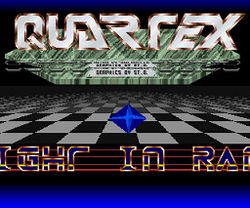
A crack intro, also known as a cracktro, loader, or just intro, is a small introduction sequence added to cracked software. It aims to inform the user which "cracking crew" or individual cracker removed the software's copy protection and distributed the crack.
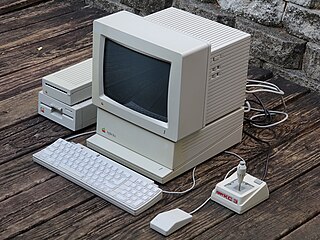
The Apple IIGS is a 16-bit personal computer produced by Apple Computer. It is the fifth and most powerful of the Apple II family. It is compatible with earlier Apple II models, but has a Macintosh look and feel, and resolution and color similar to the Amiga and Atari ST. The "GS" in the name stands for "Graphics and Sound", referring to its enhanced multimedia hardware, especially its state-of-the-art audio.
Video game music (VGM) is the soundtrack that accompanies video games. Early video game music was once limited to sounds of early sound chips, such as programmable sound generators (PSG) or FM synthesis chips. These limitations have led to the style of music known as chiptune, which became the sound of the first video games.
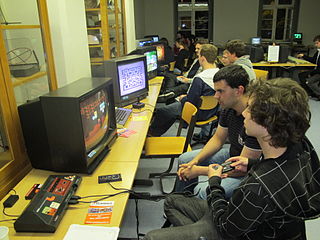
Retrogaming, also known as classic gaming and old school gaming, is the playing and collection of obsolete personal computers, consoles, and video games. Usually, retrogaming is based upon systems that are outmoded or discontinued, although ported retrogaming allows games to be played on modern hardware via ports or compilations. It is typically for nostalgia, preservation, or authenticity. A new game could be retro styled, such as an RPG with turn-based combat and pixel art in isometric camera perspective.

8 Bit Weapon is an American chiptune music band formed in Ventura County, California, by Seth and Michelle Sternberger. It was originally created by Seth Sternberger around 1998. Its instruments consists primarily of old 8-bit and 16-bit computers such as the VIC-20, Commodore 64, Commodore 128, Amiga 500, and the Apple II, as well as game consoles such as the Nintendo Entertainment System, Game Boy, Atari 2600, and an Intellivision synthesizer.
Matthew Carl Applegate, better known by the stage name Pixelh8, is a British chiptune composer, educator and screen actor.
Nintendocore is a broadly defined style of music that most commonly fuses chiptune with various hardcore punk and/or heavy metal subgenres, most often metalcore and post-hardcore. The genre is sometimes considered a direct subgenre of post-hardcore and a fusion genre between metalcore and chiptune. The genre originated in the early 2000s and peaked around the late 2000s with bands like Horse the Band, Karate High School and Sky Eats Airplane pioneering the genre.
Bitpop is a type of electronic music and subgenre of chiptune music, where at least part of the music is made using the sound chips of old 8-bit computers and video game consoles.

Halo 2600 is a 2010 action-adventure game developed by Ed Fries and published by AtariAge for the Atari 2600, a video game console released in 1977 that ended production in 1992. Inspired by the Halo video game series, the game sees players control Master Chief and fight through 64 screens with varied enemies. Completing the game once unlocks a tougher "Legendary" mode.
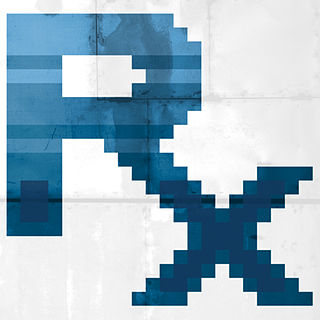
Levi "Doctor Octoroc" Buffum is an American chiptune musician and pixel artist based in Philadelphia.
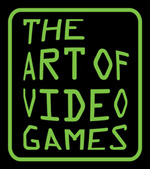
The Art of Video Games was an exhibition by the Smithsonian American Art Museum which was on display from March 16 to September 30, 2012. The exhibition was designed to highlight the evolution of art within the video game medium over its forty-year history. Following its time at the Smithsonian American Art Museum, the exhibition toured to 10 additional venues in the United States. Chris Melissinos, founder of Past Pixels and collector of video games and gaming systems, was the curator of the exhibition.

Brendan Becker, known by his stage name Inverse Phase, is an American video game composer and chiptune musician, using Atari, Commodore, and Nintendo hardware. He also speaks and hosts workshops on video game music, chiptunes, and composing.

Niamh Houston, better known by her stage name Chipzel, is a musician from Northern Ireland. She is best known for making chiptune music, particularly with a Game Boy. She is also a video game music composer, and is known for the soundtracks of games such as Super Hexagon, Interstellaria, and Dicey Dungeons. Her music is also featured in other games such as Just Shapes and Beats and Spectra.
Dr. Zilog is a chiptune metal trio from Denver, Colorado. The band blends 8-bit chiptune melodies with real guitars and drums.
References
- ↑ Parker, Lyndsey (November 21, 2010). "Sanrio Saturdays: Hello Kitty Celebrates In The City | heard - Yahoo! Music". Music.yahoo.com. Archived from the original on February 17, 2013. Retrieved January 30, 2013.
- ↑ Ohanesian, Liz (August 9, 2011). "What, Exactly, is 8-Bit Music? - Los Angeles - Music - West Coast Sound". Blogs.laweekly.com. Archived from the original on October 31, 2012. Retrieved January 30, 2013.
- ↑ Keith Stuart (March 26, 2009). "Game theory: Vintage sound chips? They are music to my ears | Technology". The Guardian. London. Retrieved January 30, 2013.
- ↑ "Smithsonian American Art Museum Presents New Exhibition "The Art of Video Games" | Newsdesk". Newsdesk.si.edu. March 1, 2012. Retrieved January 30, 2013.
- ↑ Yadron, Danny (August 7, 2010). "City Resorts to Pac-Man for a Reboot - WSJ.com". Online.wsj.com. Retrieved January 30, 2013.
- ↑ "Sanrio". Sanrio. Archived from the original on December 22, 2010. Retrieved January 30, 2013.
- ↑ "Exhibitions: The Art of Video Games / American Art". Americanart.si.edu. Retrieved January 30, 2013.
- ↑ "Official Site". ComputeHer. Archived from the original on May 12, 2013. Retrieved January 30, 2013.
- ↑ Contact Brian Crecente: Comment Facebook Twitter (December 19, 2008). "Foundation 9 News, Videos, Reviews and Gossip". Kotaku. Archived from the original on October 26, 2012. Retrieved January 30, 2013.
{{cite web}}:|author=has generic name (help) - ↑ "Loops & Samples: 8 Bit Weapon: A Chiptune Odyssey". Sonycreativesoftware.com. Retrieved January 30, 2013.
- ↑ Iam8bit
- ↑ "DeRail Games releases Panic Attack on Xbox Marketplace - DeRail Games". Derailgames.no. November 11, 2010. Retrieved January 30, 2013.